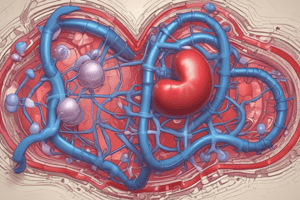Podcast
Questions and Answers
Which medication inhibits the sodium-potassium ATPase pump?
Which medication inhibits the sodium-potassium ATPase pump?
- Dobutamine
- Digoxin (correct)
- Milrinone
- Levosimendan
What is the mechanism of action of Dobutamine?
What is the mechanism of action of Dobutamine?
- Inhibit sodium-potassium ATPase pump
- Sensitize cardiac myofilaments to calcium
- Inhibit phosphodiesterase III
- Stimulate beta-1 adrenergic receptors (correct)
Which medication inhibits phosphodiesterase III?
Which medication inhibits phosphodiesterase III?
- Milrinone (correct)
- Levosimendan
- Dobutamine
- Digoxin
What is the effect of Levosimendan on myocardial contractility?
What is the effect of Levosimendan on myocardial contractility?
Which medication can lead to cardiac arrhythmias as an adverse effect?
Which medication can lead to cardiac arrhythmias as an adverse effect?
Which medication is historically used but less common now?
Which medication is historically used but less common now?
Which medication is classified as a cardiotonic/inotropic drug?
Which medication is classified as a cardiotonic/inotropic drug?
Which drug works by inhibiting the late sodium current in cardiac cells?
Which drug works by inhibiting the late sodium current in cardiac cells?
What is the primary mechanism of action of cardiotonic drugs?
What is the primary mechanism of action of cardiotonic drugs?
Which medication is NOT used to treat cardiac arrhythmias?
Which medication is NOT used to treat cardiac arrhythmias?
Which drug can exacerbate heart failure symptoms with certain anti-angina drugs?
Which drug can exacerbate heart failure symptoms with certain anti-angina drugs?
Which drug increases the levels of calcium in heart muscle cells to enhance contraction?
Which drug increases the levels of calcium in heart muscle cells to enhance contraction?
Which class of antiarrhythmics prolongs the action potential duration by delaying repolarization?
Which class of antiarrhythmics prolongs the action potential duration by delaying repolarization?
Which of the following side effects is commonly associated with digoxin use?
Which of the following side effects is commonly associated with digoxin use?
Which drug is NOT used as an antiarrhythmic agent?
Which drug is NOT used as an antiarrhythmic agent?
Which class of antiarrhythmics inhibits calcium influx into cardiac cells?
Which class of antiarrhythmics inhibits calcium influx into cardiac cells?
What is the main purpose of antihyperlipidemics?
What is the main purpose of antihyperlipidemics?
Which of the following is a common adverse effect of some antiarrhythmic drugs like amiodarone?
Which of the following is a common adverse effect of some antiarrhythmic drugs like amiodarone?
Flashcards are hidden until you start studying
Study Notes
Anti-Angina Medications
- Calcium channel blockers relax coronary and peripheral arteries, reducing myocardial oxygen demand and improving blood flow to the heart.
- Ranolazine inhibits the late sodium current in cardiac cells, reducing intracellular calcium overload and myocardial ischemia.
- Examples of anti-angina medications include nitroglycerin, beta-blockers (e.g., metoprolol, atenolol), calcium channel blockers (e.g., amlodipine, nifedipine), ranolazine (Ranexa), and isosorbide dinitrate.
Side Effects of Anti-Angina Medications
- Common side effects include headache, dizziness, flushing, fatigue, and nausea.
- Adverse effects include hypotension, reflex tachycardia, peripheral edema, and exacerbation of heart failure symptoms.
Cardiotonic/Inotropic Drugs
- These medications are used to improve the strength and efficiency of the heart's contractions, particularly in heart failure.
- They work by increasing calcium levels in heart muscle cells, enhancing contraction.
- Examples include digoxin and certain phosphodiesterase inhibitors (e.g., milrinone).
Mechanism of Action of Cardiotonic Drugs
- Cardiotonic drugs aim to enhance the strength and efficiency of cardiac contraction, particularly in heart failure.
- They primarily increase intracellular calcium levels or sensitize contractile proteins in cardiac muscle cells.
Examples of Cardiotonic/Inotropic Drugs
- Digoxin inhibits the sodium-potassium ATPase pump, leading to increased intracellular calcium and enhanced myocardial contractility.
- Dobutamine stimulates beta-1 adrenergic receptors, increasing intracellular cyclic AMP levels and enhancing myocardial contractility.
- Milrinone inhibits phosphodiesterase III, leading to increased intracellular cyclic AMP levels, which enhances myocardial contractility and vasodilation.
- Levosimendan sensitizes cardiac myofilaments to calcium, increasing myocardial contractility without increasing intracellular calcium levels.
Side Effects of Cardiotonic/Inotropic Drugs
- Common side effects include nausea, vomiting, headache, dizziness, and visual disturbances.
- Adverse effects include cardiac arrhythmias, hypotension, myocardial ischemia, thrombocytopenia, and electrolyte disturbances.
Antiarrhythmic Drugs
- Class II antiarrhythmics (beta-blockers) like metoprolol and propranolol decrease sympathetic activity, reducing heart rate and contractility.
- Class III antiarrhythmics (potassium channel blockers) like amiodarone and sotalol prolong the action potential duration, delaying repolarization.
- Class IV antiarrhythmics (calcium channel blockers) like verapamil and diltiazem inhibit calcium influx into cardiac cells, slowing conduction through the AV node and reducing heart rate.
Examples of Antiarrhythmic Drugs
- Beta-blockers (e.g., metoprolol, propranolol)
- Calcium channel blockers (e.g., verapamil, diltiazem)
- Sodium channel blockers (e.g., flecainide, propafenone)
- Potassium channel blockers (e.g., amiodarone, sotalol)
- Digoxin
Side Effects of Antiarrhythmic Drugs
- Common side effects include fatigue, dizziness, nausea, constipation or diarrhea, and blurred vision.
- Adverse effects include proarrhythmia, hypotension, bradycardia, QT prolongation, and liver toxicity.
Antihyperlipidemics
- These drugs are used to lower elevated levels of lipids (fats) in the blood, particularly cholesterol and triglycerides.
- High levels of these lipids are associated with an increased risk of cardiovascular diseases such as heart attacks and strokes.
Studying That Suits You
Use AI to generate personalized quizzes and flashcards to suit your learning preferences.




